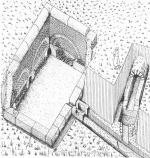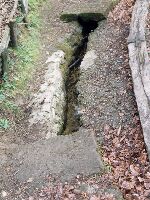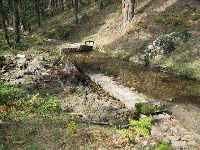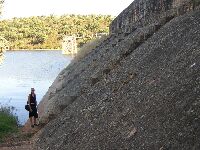



Source
There are many ways to get (ground)water into an aqueduct. The most common ones are (see also illustrations above):- Spring boxes and Well intakes
The active and passive means to collect water in a round or rectangular chamber; the water was supplied through numerous splits or specially created, sometimes arched, openings. A single outlet discharges the water from the catchment area into the aqueduct conduit. - Infiltration galleries
Infiltration galleries were sections of aqueduct gallery, 20 - 100 m long which ran along a hill side to intercept the flow of water that trickled out of the splits in the wall into the gallery. At one side the water was collected into a settling basin to get rid of the debris and sediments: the start of the aqueduct. - River intakes
A river as a source for an aqueduct was not very popular in Roman times - Dams
Springs were the commonest source for roman aqueducts. River intakes were used occasionally. Artificial created lakes as a source were rare although they could have been used to equilize the variations in the seasonal flow rates of the feeding spring(s)
In clay the supply is thin and scanty and near the surface; this will not be of the best flavour. In loose gravel the supply is scanty but it is found lower down; this water will be muddy and unpleasant. In black earth, moisture and small drops are found; when these gather after the winter rains and settle in hard solid receptacles, they have an excellent flavour. But in gravel small and uncertain currents are found; these also are of unusual sweetness. In coarse gravel, common sand and red sand, the supply is more certain, and this is of good flavour. The waters from red rock are copious and good, if they do not disperse through the interstices and melt away. At the foot of the mountains and in flinty rocks water flows more copiously; and this is more cool and wholesome. Springs on level ground are salt, coarse, lukewarm and unpleasant, unless they flow from the mountains underground, and break out in the middle of the fields, and there under the shadows of the trees they furnish the sweetness of mountain springs.Many springs were underground and had to be found. That this could present problems is clear from the stories of the discovery and naming of the Aqua Virgo. According to the story, a local girl pointed out the underground springs to Agrippa's military engineers. This story is preserved in the Trevi Fountain. Vitruvius advises engineers in search of underground water to examine soil type, surface vegetation and landscape formations. The presence of water-loving plants like willows, alders and rushes on higher-lying ground is a good sign that water lies below them. Morning mist on the landscape can indicate a source, as can bright green grass in a dry season.
Once found, the water had to be channelled. Some areas were too swampy for construction and some water too foul for consumption. A good source of water is a natural limitation on the number of aqueducts that supply a city.